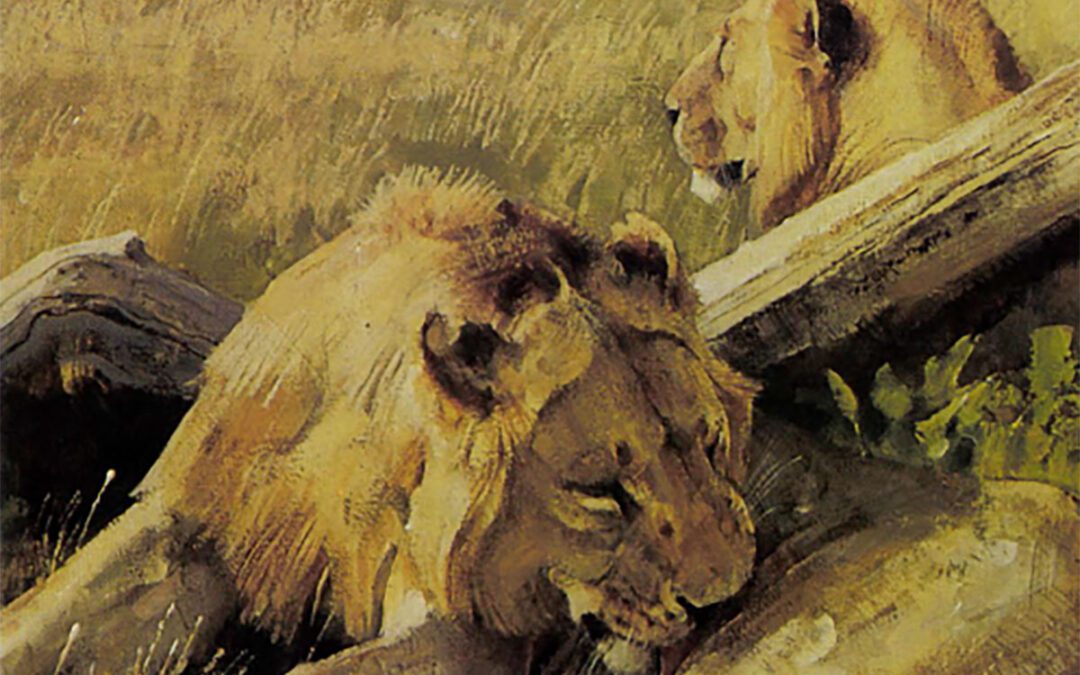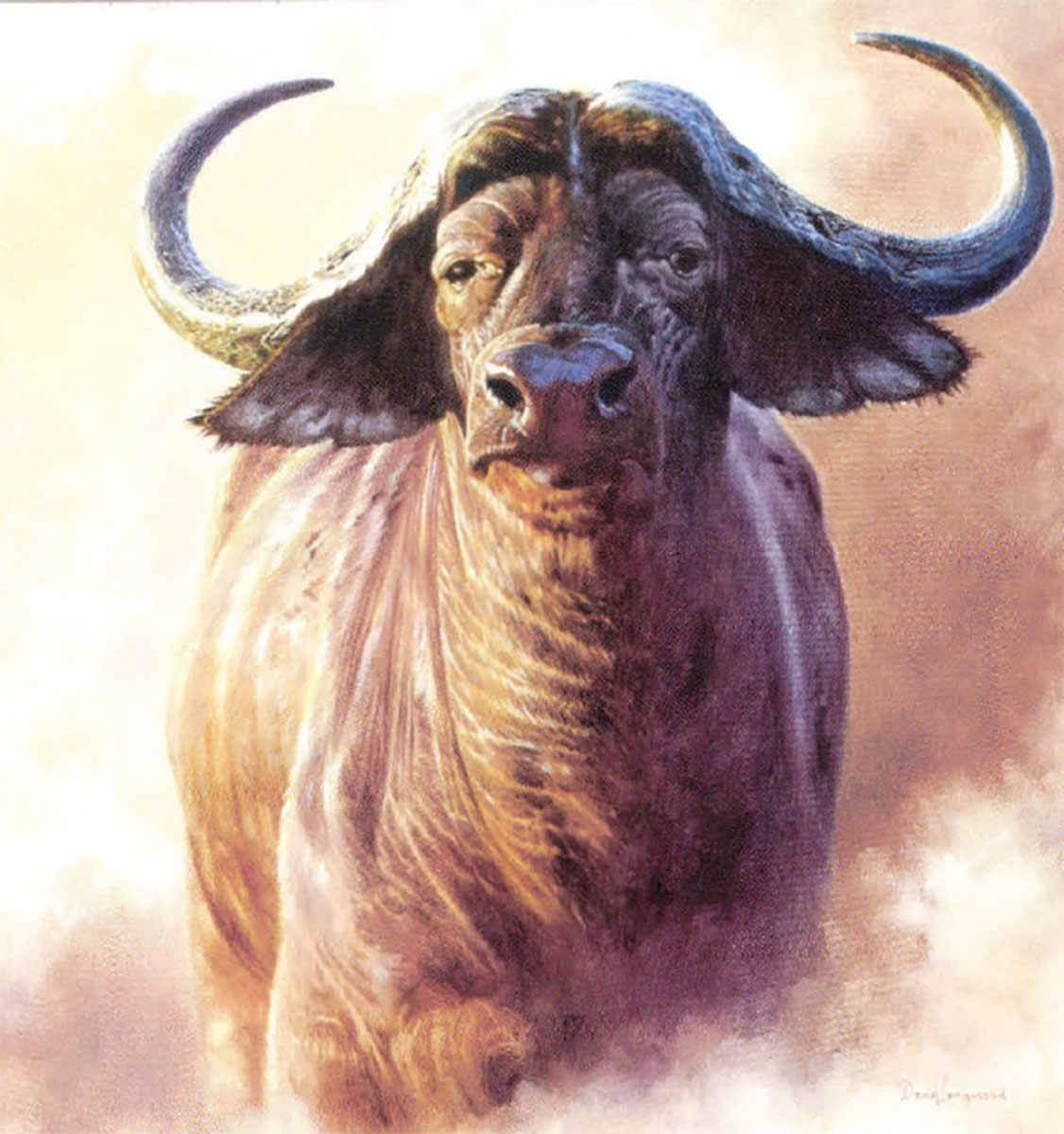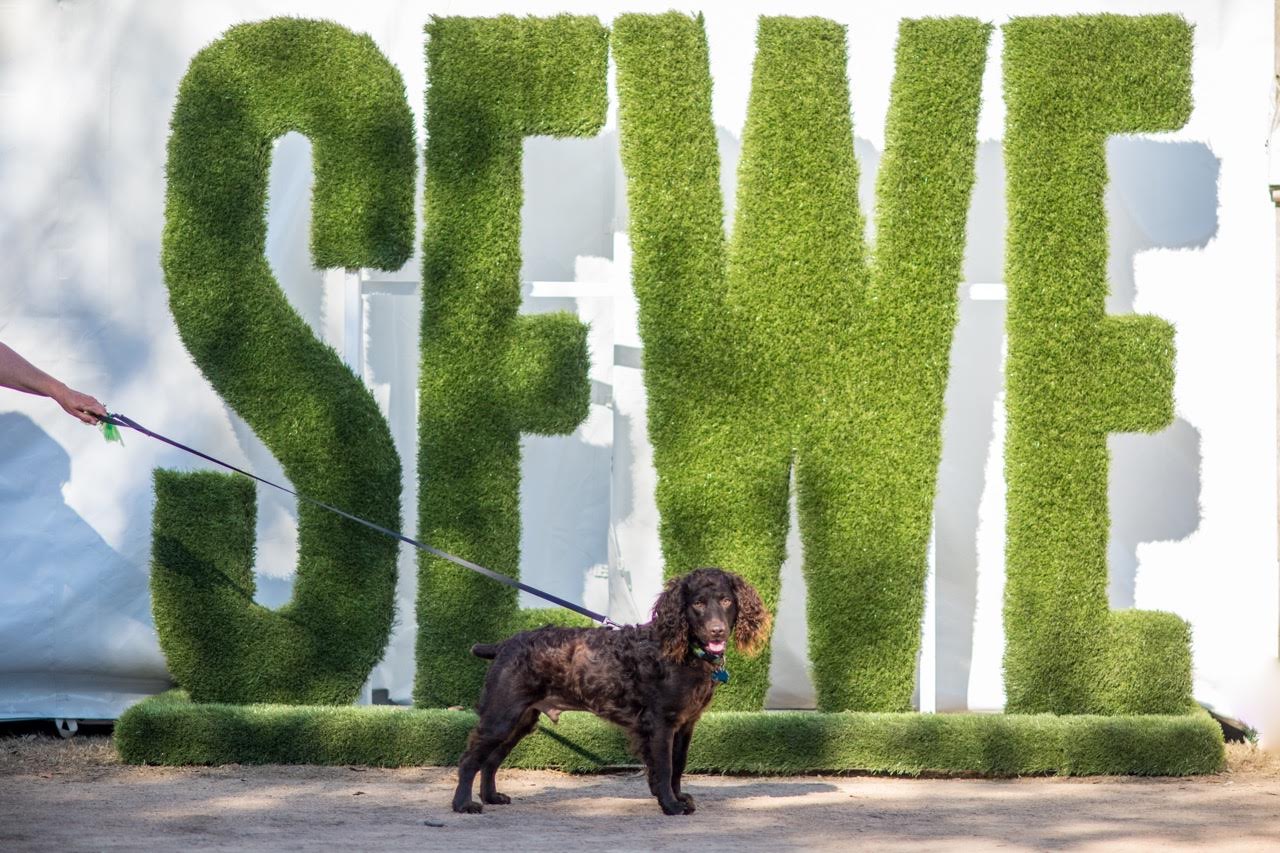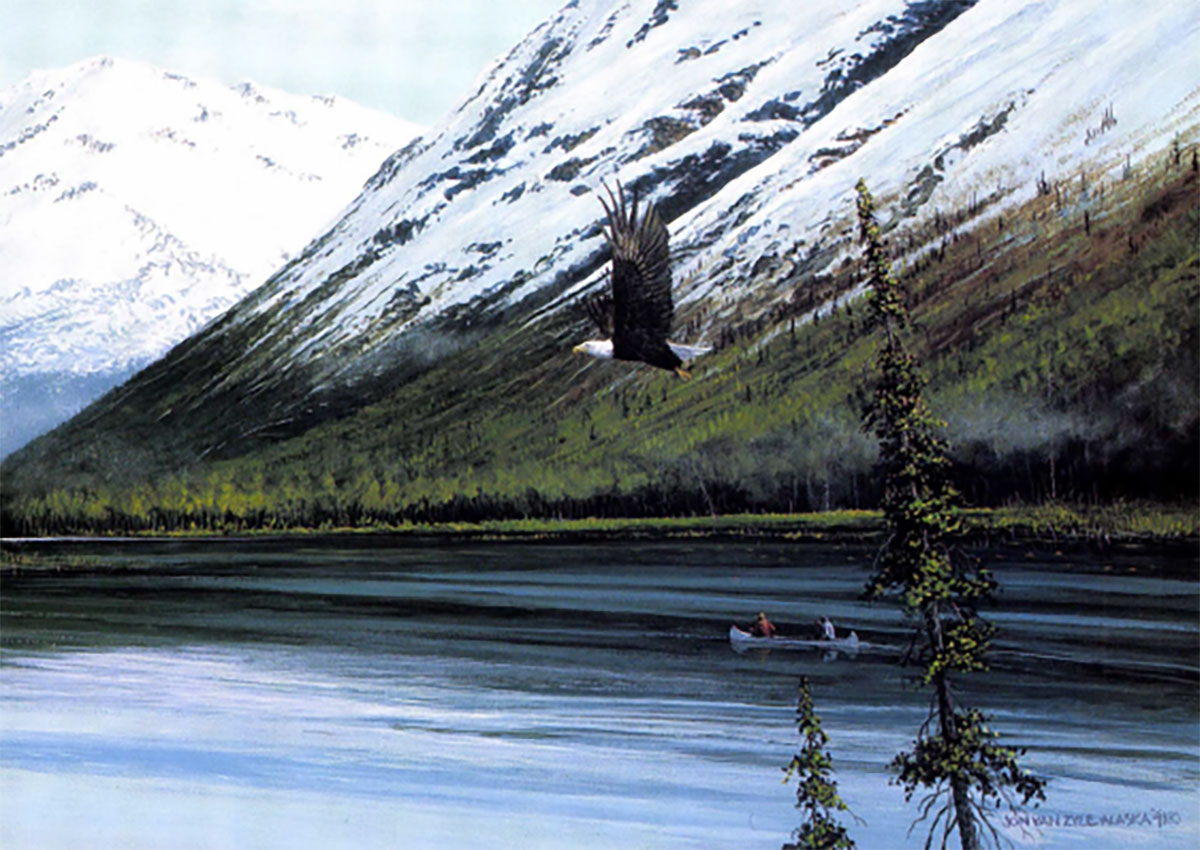Seven famed wildlife artists select their favorite pieces out of their portfolio, and give a little insight as to why.
Silence in White – by Ken Carlson
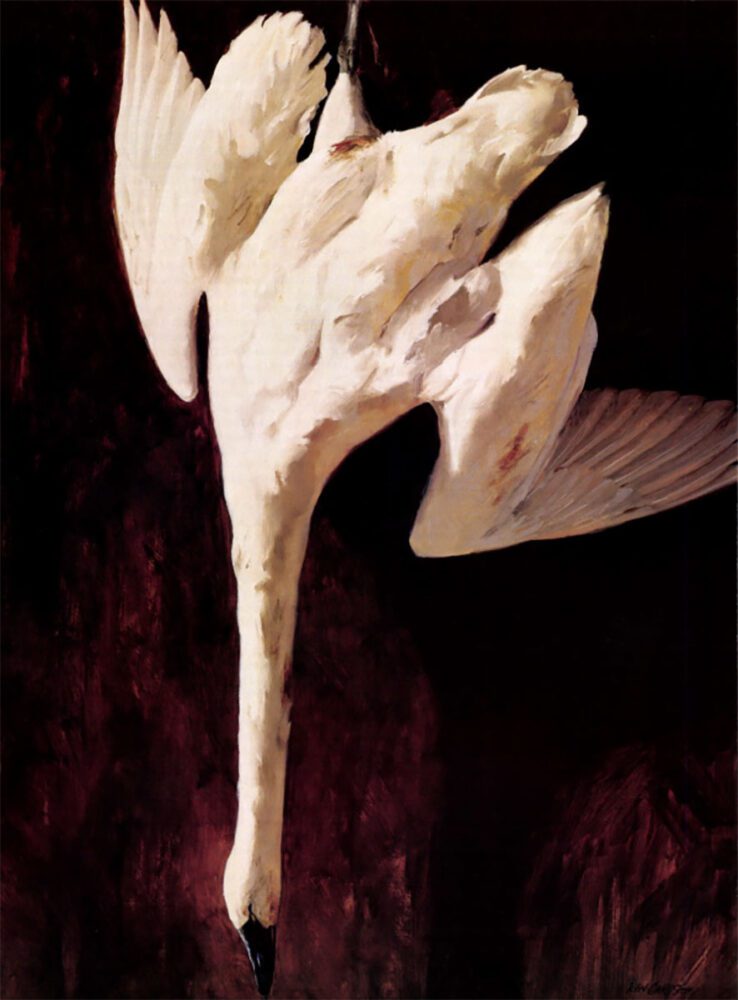
Silence in White – Ken Carlson
My selection of Silence in White was based strictly on the enjoyment I derived from creating this piece. A longtime ago I discussed the idea for this painting with Bubba Wood, owner of Collectors Covey in Dallas. But I had to put the concept on hold until a model became available. A friend went swan hunting in North Carolina and was kind enough to let me hang this handsome specimen for photographing and sketching before he had it mounted. The canvas practically painted itself. What intrigued me the most was the strong abstract shape of the bird. Using a deep red backdrop was natural in order to repeat the dried blood on the feathers. This is the type of painting that viewers immediately like or dislike. Some reactions included: “How gruesome!” and “Such a beautiful creature and yet so sad.” I didn’t think of the swan’s death while painting because all I wanted to do was capture its beauty.
Like Honey in the Sun – by Bob Kuhn
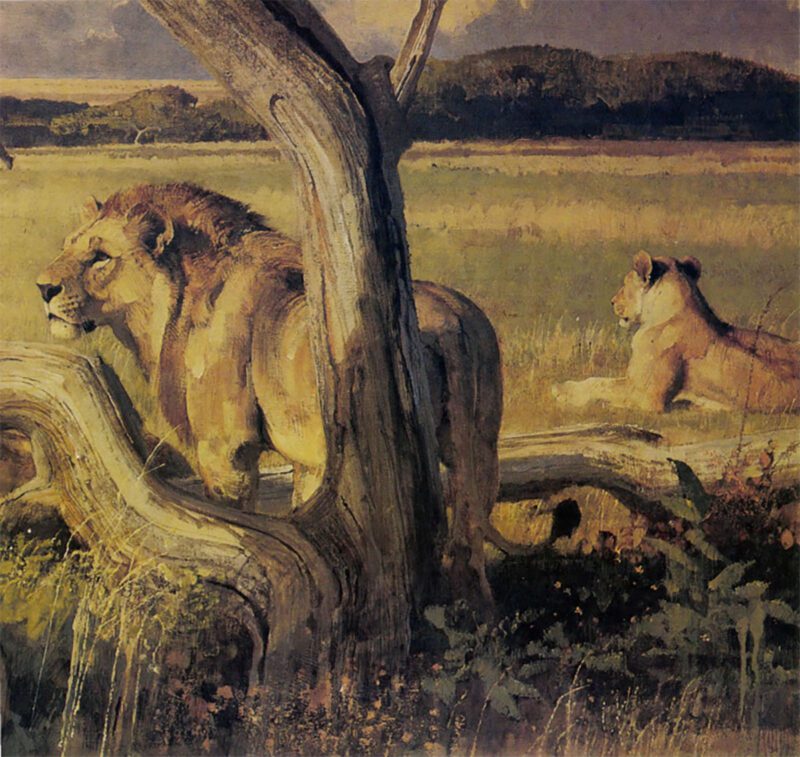
Like Honey in the Sun – Bob Kuhn (detail)
When asked to write about my favorite painting, my first reaction was one of horror. To select one painting as my preference among the several hundred that I’ve produced is fraught with peril. A substantial number of my clients are convinced they own Numero Uno. With that in mind, I’ve selected a painting I like, have no urge to change, but do not insist is my very best. Like Honey in the Sun, for openers, is about lions. I’m very comfortable with lions — at least from an artistic standpoint — having made hundreds of sketches as well as thousands of photographs of them. A number of researchers have determined that lions are relaxed and relatively inert for about 20 hours of every day — watching, sleeping, and just lying around — after which comes a pretty concentrated dose of action as they pursue their prey. On the veld, predator and prey are quite comfortable with each other as long as there is a margin of safety. This margin varies from animal to animal. Many antelope will allow lions to venture within 100 to 200 feet, but won’t let a cheetah that close because they know they would be dead meat. They also recognize the different attitudes of lions. If the big cats are just loafing, they don’t get alarmed. But when lions are walking about and showing some interest in them, prey animals like wildebeest and zebra will panic a lot quicker. Like Honey in the Sun is important for other reasons, too. The interplay of several major animal elements in relationship to a fairly complicated tree shape is also the sort of subject I enjoy trying to resolve. Further, the setting of the painting evokes memories of a time (1975) and place (Mara Game Preserve in southern Kenya). The Mara is an extension of the Serengeti, an ecosystem that supports a huge wildebeest population which in turn, supports a large number of lions. The final factor which endears this painting to me is that I had a terrible time bringing it off. It had serious problems in its first incarnation and only after reworking the major elements did the painting work. Like the parent who has a special feeling for the sickly child, I have a special fondness for Like Honey in the Sun.
The “L” – by Thomas Daly
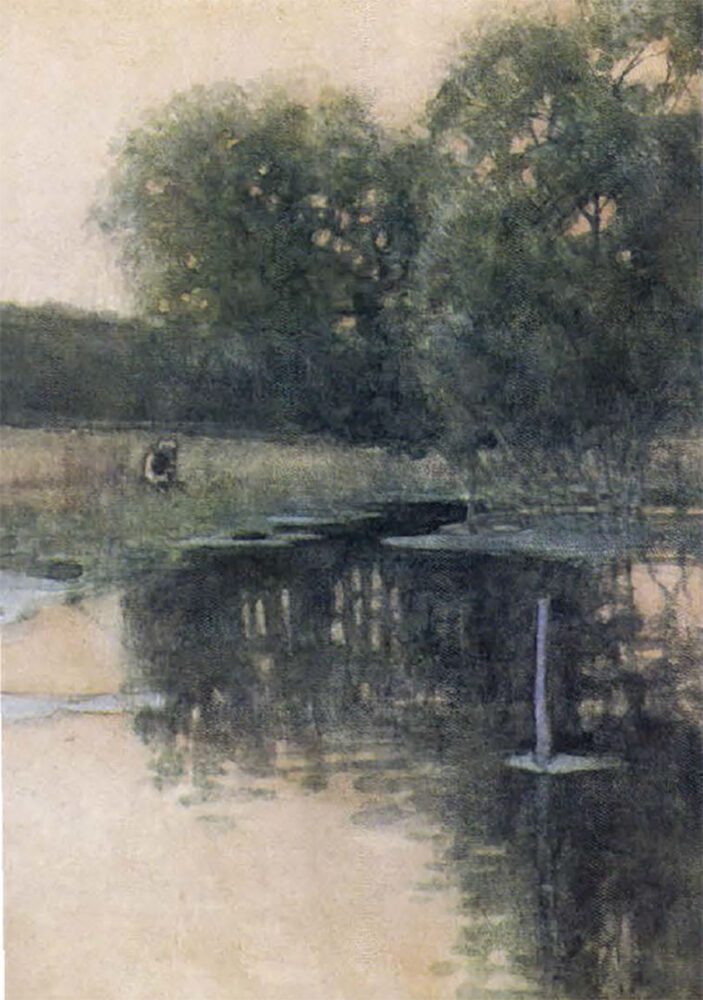
The “L” – Thomas Daly
The “L” is a special picture to me because it evokes a sense of nostalgia that supersedes its academic merit. While I am satisfied with the composition and paint quality, it is the elusive sense of place that materialized on the paper. That pleases me most. The “L” is the name local fishermen gave to a bend in a small limestone stream in Mumford, New York. The stream meanders lazily through backyards and the business district, heavily-laden with trout and watercress. Because of its unique European flavor (remindful of England’s fabled chalk streams) and its rich bounty, The “L” drew me hypnotically for over 30 years. Today The “L” no longer exists. The town has uprooted its willows and piled boulders along its banks in a civic-minded attempt to tidy up, inadvertently destroying a unique habitat in the process. I chose to paint the stream from idyllic memories of quiet spring evenings in the company of friends, fishing for the trout that gently rose to feed on hatches of bright fox, our local name for the mayfly that New England anglers recognize as the sulphur dun. There was a small church near The “L” where parishioners sang Negro hymns and spirituals that echoed across the water. On several occasions we sat there in the dark, just listening to the singing. The “L” is a personal reminiscence of a seemingly reverent fisherman tying on a fly in the ethereal serenity of a “lost” place.
Siberian Chase by Guy Coheleach
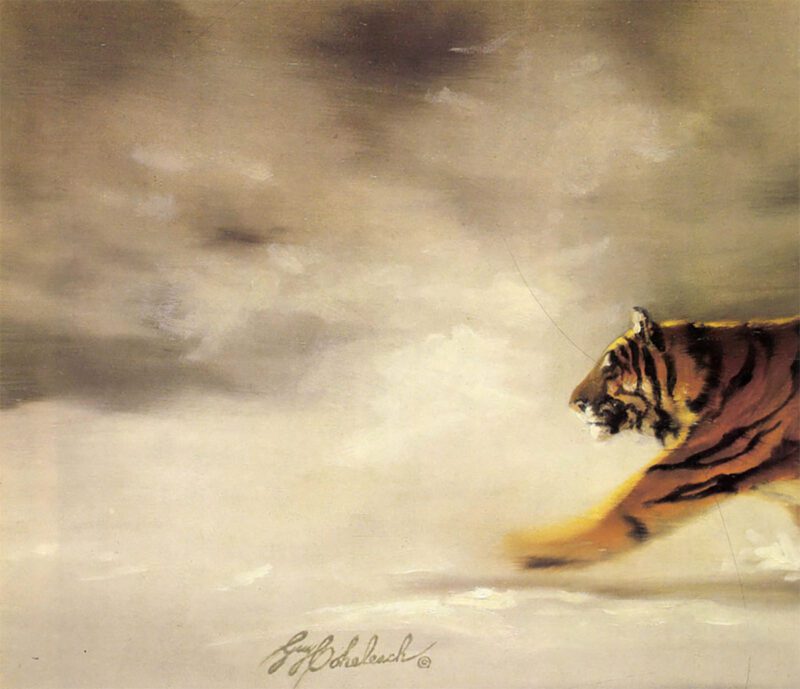
Siberian Chase – Guy Coheleach (detail)
My favorite painting is the “next one;” it has no mistakes on it — yet. As for those which are already done it is difficult for me to choose. Some I like for their grandeur, others for their subtlety. There are those I prefer for their mood or detail, others for their painterliness. This particular painting stands out because it became my favorite print. Siberian Chase proved tome that collectors of wildlife art will buy something other than pieces with fur and feathers rendered in meticulous detail. I had always liked to paint impressionistically, but never had the fortitude to print such a piece. The success of Siberian Chase was proof that at least some print buyers were ready for more “fine art” in their limited edition prints. There are better works of art among my paintings, but none are as fondly remembered as this spontaneous smattering of paint!
Up and Away – by Manfred Schatz
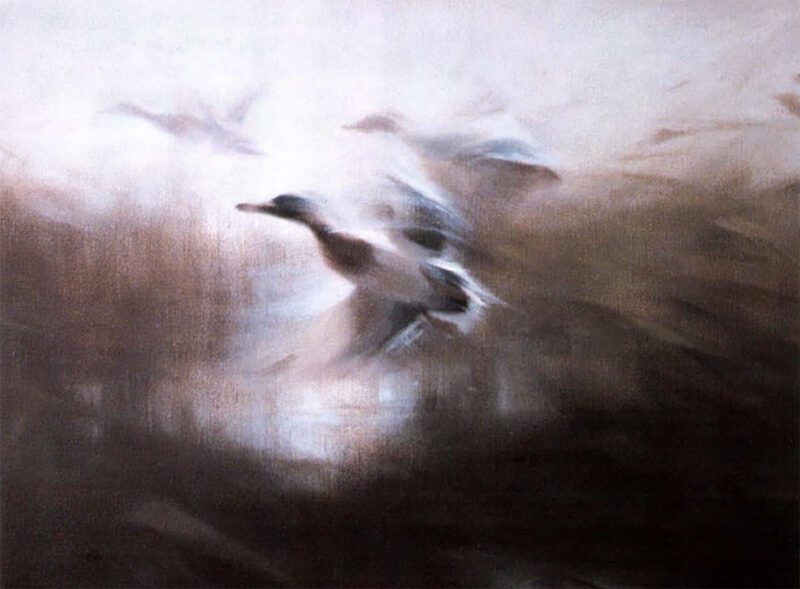
Up and Away – Manfred Schatz
In all of my lifetime as an artist, I have created at least several hundred paintings and of those, I would only consider between three and five to be above average. Up and Away is one of them. With this painting, I finally achieved what I have wished for and attempted for a long time. After numerous tries, I seem to have totally succeeded in capturing the flight of mallards ascending out of the marsh grass against the wind. I am also very satisfied with the colors, composition and how everything came together. There is a great difference between the impressionistic and realistic styles. Each brushstroke is important in this type of impressionistic painting. It could be compared to a pianist who plays in a concert. The pianist cannot afford to miss one note, or the effect of the total composition will be ruined. To understand my feelings, one would have to view this painting next to two or three of my earlier works. Yet knowing myself, I seriously doubt that I will feel the same way several years from now. Every artist continuously strives for perfection; otherwise there is no improvement. That is what makes me happy — to discover new things, to observe and to paint with brush and easel. —Translation by Mrs. Gabrielle Reddin
Jimmy’s Point — by David A. Maas
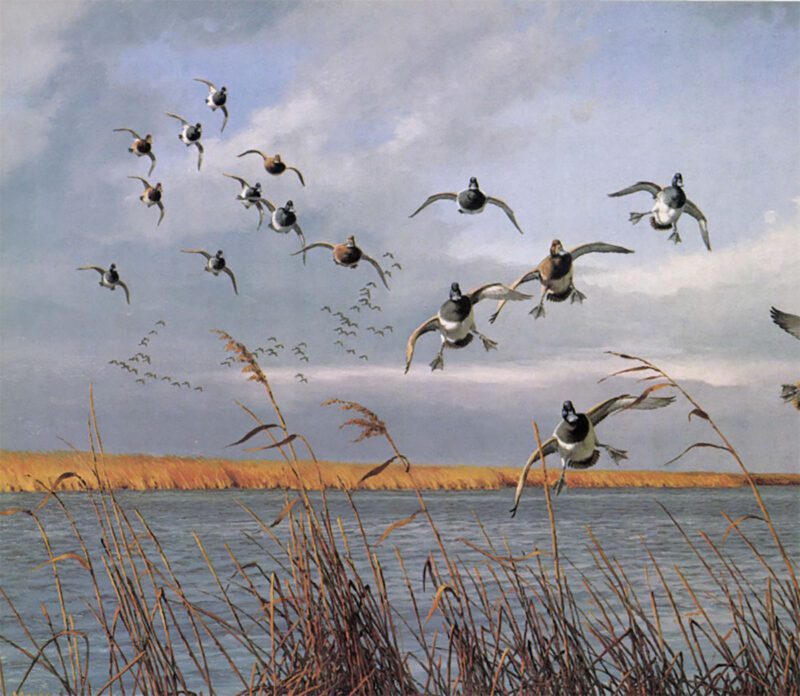
Jimmy’s Point – David A. Maass
Jimmy’s Point may not be the finest painting that I have ever produced, but it means as much to me as any I’ve done. Almost all of my favorite paintings are based on actual experiences, usually hunting trips. Often, the person I’m hunting with contributes to the inspiration that starts me painting. In this case it was Jimmy Robinson. To just about anyone who has ever carried a gun into the marsh or field, and to many who haven’t, Jimmy Robinson was probably the greatest sportsman who ever lived. Jimmy died in June of 1986, and to have had him as a close friend directly or indirectly inspired more paintings than I’ll ever know. Jimmy’s Point was painted after my first duck hunting trip with Jimmy on the vast Delta Marsh of southern Manitoba. We set up on the point which the guides had named after him. That morning, wave after wave of bluebills approached our decoys, trying to decide whether to land. This is the scene I tried to capture. I think I succeeded, at least to my own satisfaction, because every time I see the painting, I relive that memorable day.
The Pups – by Robert K. Abbett
To paraphrase Harry Truman who said the only thing new is the history that you haven’t read yet, my favorite painting is always the one “that I’m going to do next.” That painting is always marvelous in my mind — it’s perfection yet unmarred by this artist’s human limitations. But most artists do have favorites, or at least memorable paintings, and mine usually have English setters in them. In fact, high on that list is The Pups, depicting the litter which includes my own dog, Duke. Duke’s Dad was Luke. His portrait, done in 1972, was instrumental in defining my career after I left illustration to concentrate my efforts on gallery art. Luke’s owners, Tom and Martha Sweeny, lent a lot of support in those early days and one way or another I was granted pick of the litter when Luke and Diana were mated. Duke joined our household as a pup and grew to become not only a family member but a working hand as well. In the art business, his availability and talent in posing served me well in countless paintings. In the field, Duke’s infallible nose and tireless hunting rewarded me with days of pleasant companionship. The Pups is the most recent in what is now a long line of paintings featuring setters. Dukie is the third pup from the right — I think. (Identifying setter pups is sometimes a little like trying to tell one fried egg from another, but we do our best).Shown pointing or retrieving, as big dogs or as little dogs, the English setter is a powerful visual catalyst in every painting in which it appears.
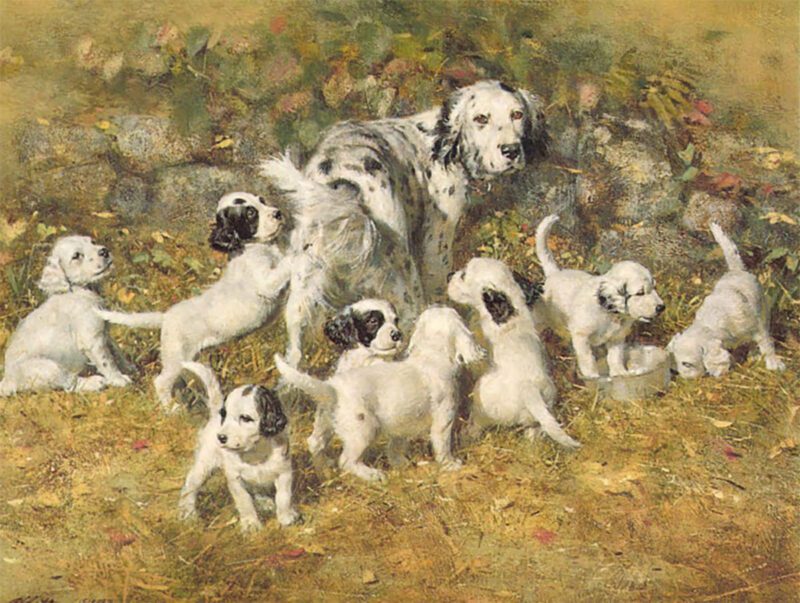
The Pups – Robert K. Abbett
Take any picture with a light-colored setter in it, even where the dog is shown quite small in relation to the entire scene, put your handover the dog’s image and you’ll see instantly how the picture will fall apart, no matter how interestingly the rest of the composition is presented. That shimmering effect of sunlight on a setter will never fail to get my creative juices going. Show me two or three or even a litter and I’m a goner!
Technically, a painting like The Pups has two major areas which can test the artist: the arrangement of the pups, and painting and capturing the satiny texture of their coats. I did many thumbnail sketches — rough scribbles done on tracing paper — just to visualize poses and positions. These I’d tear apart and rearrange in dozens of ways until the general stage setting of the group began to make itself apparent.
Painting the feel and look of dog’s coat is another ball game altogether. Like painting water or glassware, it’s important that the artist knows when to quit. Rather than actually reconstructing the material, I’m creating an illusion, at this point, giving you — the viewer — a combination of color and texture to remind you of a sensation already familiar to you. Lastly, the pups were shown in a partially vignetted background. I’ve suggested a stone wall and some autumn foliage without doing an overly realistic rendering of these elements. Again, as the viewer, you can better relate to the scene because of its non-specificity, and fill in the blanks from your own experiences.
I hope you can find something to which you relate in The Pups: From their knobby knees and weaving gaits to the calm eyes of their mother, these happy dogs show us qualities which not only mimic ourselves, but give us a moment’s pause from the day’s grittier moments.
Editor’s Note: this article originally appeared in the 1988 July/August issue of Sporting Classics.
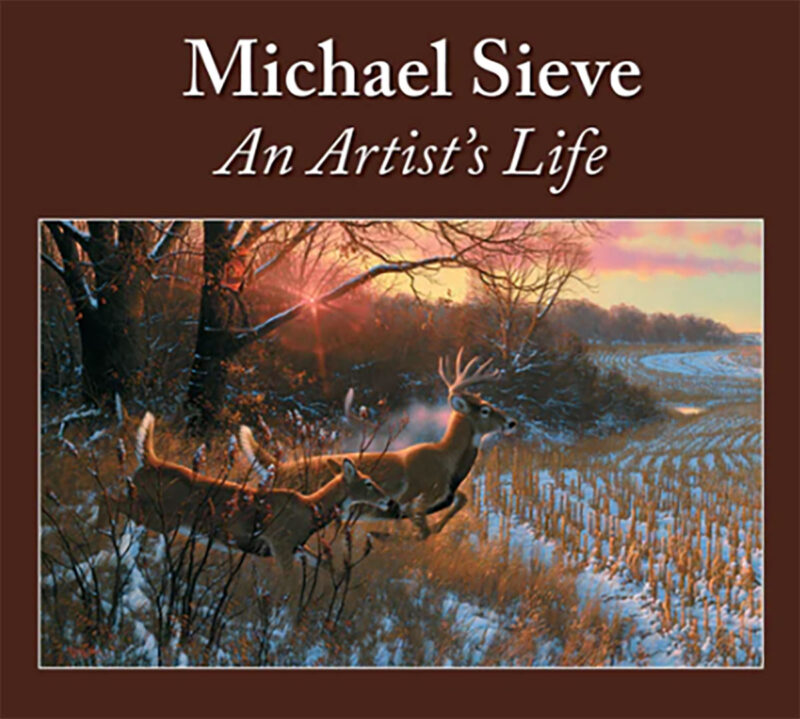 Featured on these pages are more than 280 paintings dating from the early 1970s to today. You’ll join the artist on adventure-filled journeys across North America, Central America, Africa and Asia and discover a vast portfolio of wildlife, including lions, tigers, bears, white-tailed deer and more. You’ll enjoy his gripping and refreshingly honest accounts of the experiences that inspired his artwork. In his stories, Sieve shares his deep commitment to land and wildlife conservation practices and recounts his adventures observing, photographing and hunting his wild subjects. Buy Now
Featured on these pages are more than 280 paintings dating from the early 1970s to today. You’ll join the artist on adventure-filled journeys across North America, Central America, Africa and Asia and discover a vast portfolio of wildlife, including lions, tigers, bears, white-tailed deer and more. You’ll enjoy his gripping and refreshingly honest accounts of the experiences that inspired his artwork. In his stories, Sieve shares his deep commitment to land and wildlife conservation practices and recounts his adventures observing, photographing and hunting his wild subjects. Buy Now
